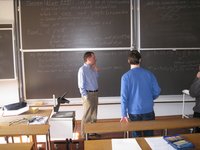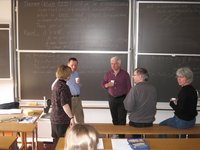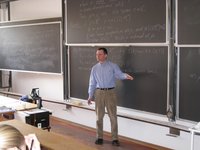Course on Advanced Valuation Theory
15-18 March 2011, Aarhus University
Lectures by Andreas Bernig, Goethe-Universität Frankfurt.
Tuesday 15 March
10:15-11:00 and 11:15-12:00 in Aud. D3
Translation invariant valuations
We will study the space of translation invariant continuous valuations. The first main theorem is McMullen's decomposition theorem which we will prove. Then we formulate Alesker's irreducibility theorem and deduce some important corollaries like McMullen's conjecture.
Wednesday 16 March
10:15-11:00 and 11:15-12:00 in Aud. D3
The Klain embedding
We will prove Klain's injectivity theorem. This theorem is useful to describe even valuations by functions on some Grassmannian manifold. The corresponding embedding in the odd case, the Schneider embedding, will be sketched.
Thursday 17 March
10:15-11:00 and 11:15-12:00 in Aud. D3
Algebraic structures on the space of valuations
The space of translation invariant valuations carries some geometrically natural algebraic structures: a graded product structure, a convolution product structure and a Fourier transform relating these two.
Friday 18 March
10:15-11:00 and 11:15 and 12:00 in Aud. D3
Integral geometry of SO(n) and other groups
If a group G acts transitively on the unit sphere bundle of a vector space V, then the space of translation invariant, G-invariant continuous valuations is finite-dimensional. The best known and classical case is G=SO(n).
We will show in detail how the material from the preceding lectures shed new light on several well-known theorems like Hadwiger's characterization theorem and the principal kinematic formula. The main theorem is the fundamental theorem of algebraic integral geometry, which will be proved.
Literature
A detailed script will be distributed at the end of the lectures. As background for lectures 1 and 4, we recommend the book by Klain and Rota: Introduction to Geometric Probability. Most of the material presented in this lecture series is also described in two survey papers by J. Fu and A. Bernig, both entitled Algebraic integral geometry.







